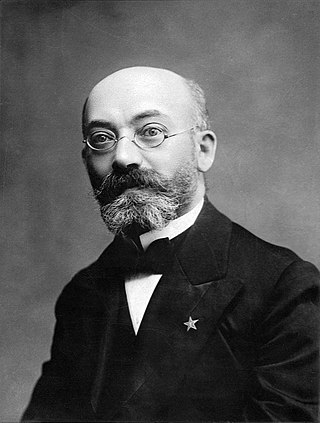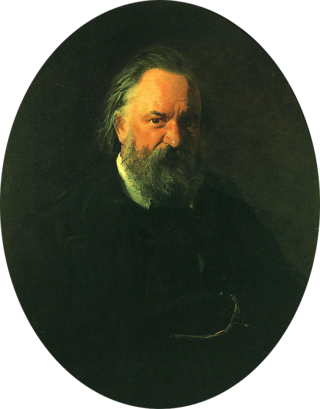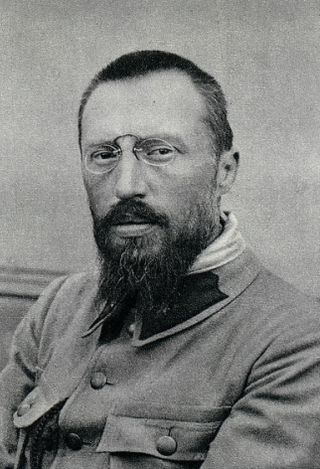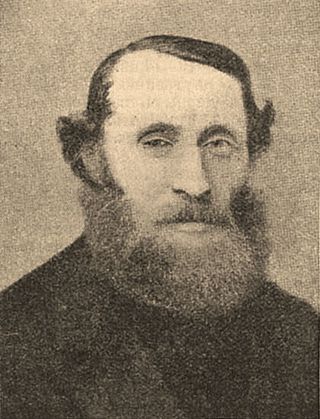
Isaiah Bershadsky (1872-1908) born Isaiah Domachevitsky, was a novelist from the Russian Empire.

Isaiah Bershadsky (1872-1908) born Isaiah Domachevitsky, was a novelist from the Russian Empire.
Born in Saimoscha, near Slonim, government of Grodno, 1874; later a teacher in Yekaterinoslav. Bershadsky was one of the youngest Neo-Hebraic writers of fiction in Russia. Bershadsky died in 1908 in Warsaw.
His "Zikronot Tugah" (Sad Memories), in "Ha-Shiloah," vi. 405-416, is the story of a Talmudist who went into business, imitated the vices and extravagances of the rich, and, after being ruined by living above his means (a fault common to old-style Russian merchants), is a mental and physical wreck at fifty-five, with a devoted wife who did not share his pleasures but comforts him in his despair. In his silhouettes, "Ma'asim be-Kol Yom" (Every-Day Occurrences), which appeared in the "Aḥiasaf" calendar for 1901, he places before the reader memorable types and incidents. The best of them is probably "Ha-Shemu'ah" (The Report). This describes the agony of a liberal Jew when he learns from his sons, whom he has established in business in a great city, that they are compelled to embrace Christianity in order not to be ruined by expulsion. The anomalies of religious life are presented in their most cruel phases; for the author states that the old man was liberal and cared little about the religious conduct of his sons, sometimes even encouraging transgression in small things, but that he is crushed by their conversion, which is to some extent the outcome of their training under his supervision.
In his novel, "Be'en Maṭṭarah" (Without Aim), Bershadsky described the life of progressive Hebrew teachers in Russia, and the superiority of a Zionist idealist over a brilliant cynic, Adamovich, who is the hero of the novel, and who has no aim in life. These novels as well as two others, "Defusim u-Ẓelalim" (Types and Shades) and "Neged ha-Zerem" (Against the Current), were published by the "Tuschia" of Warsaw. Bershadsky also contributed several short sketches to "Ha-Dor."

L. L. Zamenhof was an ophthalmologist who lived for most of his life in Warsaw. He is best known as the creator of Esperanto, the most widely used constructed international auxiliary language.

Henrik Pontoppidan was a Danish realist writer who shared with Karl Gjellerup the Nobel Prize for Literature in 1917 for "his authentic descriptions of present-day life in Denmark." Pontoppidan's novels and short stories — informed with a desire for social progress but despairing, later in his life, of its realization — present an unusually comprehensive picture of his country and his epoch. As a writer he was an interesting figure, distancing himself both from the conservative environment in which he was brought up and from his socialist contemporaries and friends. He was the youngest and in many ways the most original and influential member of the Modern Break-Through.

Israel Zangwill was a British author at the forefront of cultural Zionism during the 19th century, and was a close associate of Theodor Herzl. He later rejected the search for a Jewish homeland in Palestine and became the prime thinker behind the territorial movement.

Alexander Ivanovich Herzen was a Russian writer and thinker known as the "father of Russian socialism" and one of the main fathers of agrarian populism. With his writings, many composed while exiled in London, he attempted to influence the situation in Russia, contributing to a political climate that led to the emancipation of the serfs in 1861. He published the important social novel Who is to Blame? (1845–46). His autobiography, My Past and Thoughts, is often considered one of the best examples of that genre in Russian literature.

Hayim Nahman Bialik was a Jewish poet who wrote primarily in Hebrew but also in Yiddish. Bialik was one of the pioneers of modern Hebrew poetry. He was part of the vanguard of Jewish thinkers who gave voice to the breath of new life in Jewish life. Being a noted essayist and story-teller, Bialik also translated major works from European languages. Although he died before Israel became a state, Bialik ultimately came to be recognized as Israel's national poet.

Yosef Haim Brenner was a Hebrew-language author from the Russian Empire, and one of the pioneers of modern Hebrew literature.

Isaiah or Yeshayahu ben Avraham Ha-Levi Horowitz, , also known as the Shelah HaKaddosh after the title of his best-known work, was a prominent rabbi and mystic.
Isaac ben Moses of Vienna, also called Isaac Or Zarua or the Riaz, was among the greatest rabbis of the Middle Ages. He was probably born in Bohemia and lived between 1200 and 1270. He attained his fame in Vienna and his major work, the halachic guide known as the Or Zarua, was very popular among Ashkenazic Jewry. He was a member of the Chassidei Ashkenaz and studied under many scholars, including the Ra'avyah, Rabbi Yehudah HaChasid, the Sar mi'Kutzi and Rabbi Elazar Rokeach. He was among the teachers of Rabbi Meir of Rothenburg.

Shlomo ben Avraham ibn Aderet was a medieval rabbi, halakhist, and Talmudist. He is widely known as the Rashba, the Hebrew acronym of his title and name: Rabbi Shlomo ben Avraham.

Solomon Buber was a Jewish Galician scholar and editor of Hebrew works. He is especially remembered for his editions of Midrash and other medieval Jewish manuscripts, and for the pioneering research surrounding those texts.
Aaron ben Joseph of Constantinople, was an eminent teacher, philosopher, physician, and liturgical poet in Constantinople, the capital of the Byzantine Empire.

Jerzy Żuławski was a Polish literary figure, philosopher, translator, alpinist and patriot whose best-known work is the science-fiction epic, Trylogia Księżycowa, written between 1901 and 1911.

Moshe Leib Lilienblum was a Jewish scholar and author. He also used the pseudonym Zelaphchad Bar-Chuschim.
Moses Hagiz was a Talmudic scholar, rabbi and writer born in Jerusalem during the time of the Old Yishuv. He was also one of the most prominent and influential Jewish leaders in 17th-century Amsterdam. During Hagiz's lifetime, there was an overall decline in rabbinic authority which was the result of migration and assimilation, and Hagiz devoted his career to restoring rabbinic authority. His most prominent talent was as a polemicist, and he campaigned ceaselessly against Jewish heresy in an attempt to unify the rabbinate.
The Land of Onias is the name given in Hellenistic Egyptian, Jewish, and Roman sources to an area in Ancient Egypt's Nile delta where a large number of Jews settled. The Land of Onias, which included the city of Leontopolis, was located in the nome of Heliopolis. While accounts differ on the details, it is known that the Jews of Leontopolis had a functioning temple, distinct from and contemporary to the one in Jerusalem, presided over by kohanim (priests) of the family of Onias IV, for whom the "Land of Onias" is named. Aside from a somewhat uncertain allusion of the Hellenist Artapanus, only Josephus gives information about this temple. The Talmudic accounts are internally contradictory. The establishment of a central sanctuary in Egypt was probably undertaken in response, in part, to the disorders that arose in Judea under Antiochus IV Epiphanes, the desecration of the Temple at Jerusalem under his reign, the supplanting of the legitimate family of priests by the installation of Alcimus, the personal ambition of Onias IV, and the vast extent of the Jewish diaspora in Egypt that created a demand for a sanctuary of this nature.
Simhah Reuben Edelmann was a Russian grammarian and commentator. He received a good Talmudical education at home and later at the yeshivah of Volozhin. He lived in Rossein for about thirty years, mainly in the employ of a rich merchant of the name of Gabrilovitch, but for a part of the time in business for himself. Edelmann was the first to discover the latent talent of the poet Judah Loeb Gordon, for whom he obtained a position as teacher in Gabrilovitch's house. After the death of his wife Edelmann left Rossein and lived for a short time in Tels (1867). Later he was employed successively in Mohilev and Königsberg. In his later days he was again in business for himself, first in Brest and then in Kovno, and at last settled in Warsaw, the home of his surviving children, where he died.

Isaac Mayer Dick was a Russian Hebraist, Yiddishist, and novelist.

Yakov Lidski was a Warsaw-based Jewish bookseller and publisher, pioneer of Yiddish literature publishing. Founder of “Progress” publishing house, which was the first to publish modern Yiddish literature, and co-founder and owner of the important publishing syndicate “Central.”

Chava Shapiro, known also by the pen name Em Kol Chai, was a Russian Jewish writer, critic, and journalist. A pioneer of Hebrew women's literature and feminist literary criticism, Shapiro was among the most prolific of the diasporic women writers of Hebrew in the early twentieth century.
Isaac Jacob Weissberg was a Russian Hebrew writer and educator. He contributed articles to various Hebrew periodicals, including Ha-Melitz, Ha-Maggid, Ha-Tzfira, Ha-Shaḥar, Ha-Boker Or, Otzar ha-Sifrut, Aḥiasaf, Ha-Shiloaḥ, Ha-Goren, Ha-Pisgah, and Ha-Tikvah.